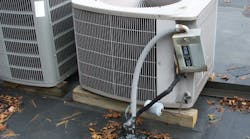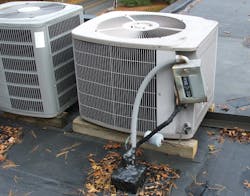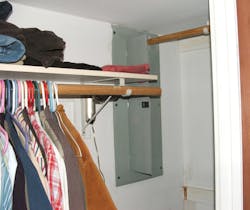Illustrated Code Catastrophes: Sections 110.26, 240.24, 312.2 and Art. 404
Which Way is Up?
This weatherproof disconnect is not so weatherproof when it’s installed upside down! Section 404.4 requires a surface-mounted switch to be enclosed in a weatherproof enclosure or cabinet. While this general-use switch is a weatherproof-type unit, it is certainly not installed properly. Section 312.2 requires surface-type enclosures to be placed or equipped so as to prevent moisture or water from entering and accumulating within the enclosure. They are also required to be placed so there is at least a ¼-in. airspace between the enclosure and the supporting surface. Enclosures in wet locations shall be weatherproof, and raceways or cables entering above the level of uninsulated energized parts shall use fittings that are listed for wet locations. Also, Section 404.7 requires general use switches to clearly indicate whether they are in the “off” or “on” position. Switch or circuit breaker handles that operate vertically, shall be installed so that the “up” position of the handle is the “on” position. For this switch, “up” is “off” and “down” is “on.” This could cause confusion and create a hazard if a person were to only notice the handle position.
Honey, Where Are My Shirts?
According to 240.24(D), overcurrent devices shall not be located in the vicinity of easily ignitable material. Not only is this panelboard installed in the vicinity of easily ignitable clothing, but the clothes were also hanging directly in front of the open panel door. I actually had to remove some shirts from the closet rods in order to find the panelboard. Any arc or spark from a circuit breaker tripping from a fault could have ignited the clothing, which was in direct contact with the circuit breakers. The higher closet rod is also butted right up against the panel cover. You must remove this closet rod before you can remove the cover. In addition, 240.24(A) requires overcurrent devices to be readily accessible. The need to remove the clothing from the rods does not meet the definition of readily accessible, as noted in Art. 100. The safe working space required by 110.26 has also been compromised. Working space required by this section shall not be used for storage of items.






